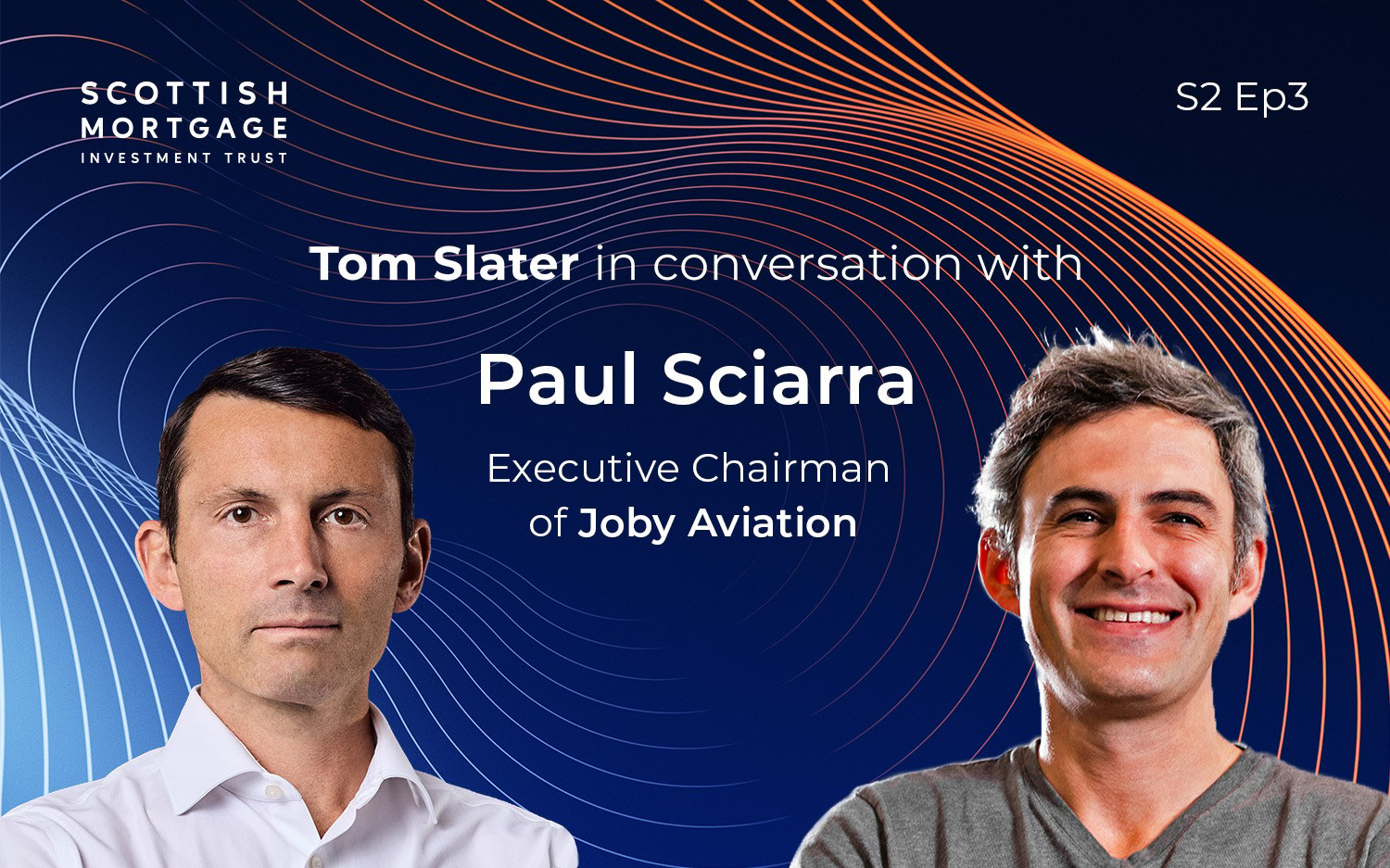Joby Aviation: preparing for takeoff
Claire Shaw – Portfolio Director
Key Points
- Urban congestion and the costs of building new ground infrastructure make it difficult to improve the efficiency of existing modes of transport
- In the latest episode of Invest in Progress, Paul Sciarra, Executive Chairman of Joby Aviation, tells Tom Slater how its electric aircraft will provide a quicker, quieter and greener way to travel
- As the company continues to scale production and roll out its operations, it is poised to have a significant impact on the future of urban transportation

As with any investment, your capital is at risk.
What if I told you that you could complete a commute that typically takes an hour and a half, in just 10 minutes? And what if I told you that this journey would be in an electric aircraft, operating in the sky above busy city centres?
You might think that this is the stuff of science fiction. However in the latest episode of the Invest in Progress podcast, we welcome Paul Sciarra, the Executive Chairman of Joby Aviation to explain how this is close to becoming a reality.
Joby Aviation is the leading developer and operator of all electric vertical take-off and landing (eVTOL) aircraft. These aircraft have features resembling an SUV, take off and land like a helicopter, but fly like a traditional aircraft. They are fully electric, delivering a quiet, fast and green aerial transportation for trips anywhere between zero and 100 miles. And the end goal is to commercialise the aircraft as an “aerial taxi service”. In other words, the Uber of the skies.
Reimagining what is possible
Before joining Joby, Paul was CEO and President of Pinterest, the consumer internet company that he co-founded. Though excited about the trajectory that Pinterest was on, he wanted a new challenge.
Around that time, Tesla was showing what was possible with electric vehicles. He reflects, “The question for me was what other areas of transportation could be impacted? And maybe one of the obvious leaps was to aviation. … This felt like an important white space that was not sufficiently explored.”
By taking to the skies with electric aircraft, the team at Joby harnessed the opportunity to address congestion, decrease operating costs, limit the carbon footprint and reduce the noise of aircraft – a critically important point for getting buy-in to operate in busy cities.
Joby has spent over a decade developing its aircraft, working closely with the Federal Aviation Administration to provide a safe and certified product.
With 10,000 flight tests behind it, the company has demonstrated that its aircraft is not only safe but is “100 times quieter than a helicopter during a flyover, and ten times quieter during take-off or landing.”

Listen to the latest episode of the Invest in Progress podcast, to discover how close Joby Aviation is to making flying taxis a reality in high-traffic areas.
Listen to the podcast here.
Making it work on the ground
But the aircraft itself is just one piece of the puzzle. Paul explains that from an operational standpoint, the issue is “the inability to build new infrastructure, bridges, roads and tunnels. The costs are astronomical,”.
With that in mind, Joby has designed its aircraft to be able to utilise infrastructure already there. The company uses existing helipads for example, and has struck up partnerships with real estate companies and parking garage operators to make use of these existing commercial spaces. These spaces will make way for ‘skyports’ – the point at which a passenger will board the aircraft.
A multi-modal model
And there’s another piece of the puzzle. How the passenger gets to and from these skyports. The vision for Joby is that these aircraft fit into the existing menu of urban travel options for passengers. For example, their ‘hero route’ is that from JFK airport to Manhattan. A passenger would get off their long-haul flight at JFK airport, board their Joby aircraft to take them into the city, where an Uber would be waiting to transport them to the hotel.
So although it would be reasonable to assume the likes of Uber would be a competitor for Joby, these companies are partners, working together to “build seamless integration between these different modes of transportation because that’s what is going to save passengers the most time and deliver the most value.”
Another strong foundation is the company’s partnership with Toyota, which has provided “real assistance in designing and scaling up the aircraft's manufacturing programme”. Toyota's expertise in automotive manufacturing and investment means Joby is well-positioned to scale production at its new production facility in Ohio.
Paul also highlights the delivery of the first aircraft to the US Air Force at Edwards Air Force Base as “a critical milestone for Joby and the industry as a whole, as it marks the first eVTOL aircraft delivery to a customer anywhere in the world.”
But its importance is equally in what it enables. He notes, “We’re going to learn many things that we need to learn for commercial service well ahead of executing it.” Plus, it will allow the public to see the aircraft in flight and be reassured that the technology works before a commercial service launch.
Transforming urban transport
Scottish Mortgage’s investment in Joby Aviation is driven by the belief that its early entry, innovative technology and strategic partnerships, position it at the forefront of the eVTOL market.
Slater highlights the importance of safety and certification in the company’s success. But if you think about what transforming urban travel could look like, he says “you very rapidly get into an opportunity that's worth billions, tens of billions. It’s such a universal need, it's an enormous market if they can get it right.”
About the author - Claire Shaw
Portfolio Director
Claire Shaw is a portfolio director and plays a prominent role in servicing Scottish Mortgage’s UK shareholder base. Before joining in 2019, she spent over a decade as a fund manager with a focus on managing European equity portfolios for a global client base. With a background in analysing companies and communicating investment ideas, Claire is also responsible for creating engaging content that makes the Scottish Mortgage portfolio accessible to all its shareholders. Beyond that, she works closely with the managers, meeting with portfolio companies and conducting in-depth portfolio discussions with shareholders.
Regulatory Information
This content was produced and approved at the time stated and may not have been updated subsequently. It represents views held at the time of production and may not reflect current thinking. Read our Legal and regulatory information for further details.
A Key Information Document is available by visiting our Documents page. Any images used in this content are for illustrative purposes only.
This content does not constitute, and is not subject to the protections afforded to, independent research. Baillie Gifford and its staff may have dealt in the investments concerned. The views expressed are not statements of fact and should not be considered as advice or a recommendation to buy, sell or hold a particular investment.
Baillie Gifford & Co and Baillie Gifford & Co Limited are authorised and regulated by the Financial Conduct Authority (FCA). The investment trusts managed by Baillie Gifford & Co Limited are listed on the London Stock Exchange and are not authorised or regulated by the FCA.
Baillie Gifford Asia (Hong Kong) Limited 柏基亞洲(香港)有限公司 (BGA) holds a Type 1 licence from the Securities and Futures Commission of Hong Kong to market and distribute Baillie Gifford’s range of collective investment schemes and closed-ended funds such as investment trusts to professional investors in Hong Kong.
Baillie Gifford Asia (Singapore) Private Limited (BGAS) is regulated by the Monetary Authority of Singapore as a holder of a capital markets services licence to conduct fund management activities for institutional investors and accredited investors in Singapore. BGA and BGAS are wholly owned subsidiaries of Baillie Gifford Overseas Limited, which is wholly owned by Baillie Gifford & Co.
Europe
Scottish Mortgage Investment Trust PLC (the “Company”) is an alternative investment fund for the purpose of Directive 2011/61/EU (the “AIFM Directive”). Baillie Gifford & Co Limited is the alternative investment fund manager (“AIFM”) of the Company and has been authorised for marketing to Professional Investors in this jurisdiction.
This content is made available by Baillie Gifford Investment Management (Europe) Limited (“BGE”), which has been engaged by the AIFM to carry out promotional activities relating to the Company. BGE is authorised by the Central Bank of Ireland as an AIFM under the AIFM Regulations and as a UCITS management company under the UCITS Regulation. BGE also has regulatory permissions to perform promotional, advisory and Individual Portfolio Management activities. BGE has passported its authorisations under the mechanisms set out in the AIFM Directive.
Belgium
The Company has not been and will not be registered with the Belgian Financial Services and Markets Authority (Autoriteit voor Financiële Diensten en Markten / Autorité des services et marchés financiers) (the FSMA) as a public foreign alternative collective investment scheme under Article 259 of the Belgian Law of 19 April 2014 on alternative collective investment institutions and their managers (the Law of 19 April 2014). The shares in the Company will be marketed in Belgium to professional investors within the meaning the Law of 19 April 2014 only. Any offering material relating to the offering has not been, and will not be, approved by the FSMA pursuant to the Belgian laws and regulations applicable to the public offering of securities. Accordingly, this offering as well as any documents and materials relating to the offering may not be advertised, offered or distributed in any other way, directly or indirectly, to any other person located and/or resident in Belgium other than to professional investors within the meaning the Law of 19 April 2014 and in circumstances which do not constitute an offer to the public pursuant to the Law of 19 April 2014. The shares offered by the Company shall not, whether directly or indirectly, be marketed, offered, sold, transferred or delivered in Belgium to any individual or legal entity other than to professional investors within the meaning the Law of 19 April 2014 or than to investors having a minimum investment of at least EUR 250,000 per investor.
Germany
The Trust has not offered or placed and will not offer or place or sell, directly or indirectly, units/shares to retail investors or semi-professional investors in Germany, i.e. investors which do not qualify as professional investors as defined in sec. 1 (19) no. 32 German Investment Code (Kapitalanlagegesetzbuch – KAGB) and has not distributed and will not distribute or cause to be distributed to such retail or semi-professional investor in Germany, this document or any other offering material relating to the units/shares of the Trust and that such offers, placements, sales and distributions have been and will be made in Germany only to professional investors within the meaning of sec. 1 (19) no. 32 German Investment Code (Kapitalanlagegesetzbuch – KAGB).
Luxembourg
Units/shares/interests of the Trust may only be offered or sold in the Grand Duchy of Luxembourg (Luxembourg) to professional investors within the meaning of Luxembourg act by the act of 12 July 2013 on alternative investment fund managers (the AIFM Act). This document does not constitute an offer, an invitation or a solicitation for any investment or subscription for the units/shares/interests of the Trust by retail investors in Luxembourg. Any person who is in possession of this document is hereby notified that no action has or will be taken that would allow a direct or indirect offering or placement of the units/shares/interests of the Trust to retail investors in Luxembourg.
Switzerland
The Trust has not been approved by the Swiss Financial Market Supervisory Authority (“FINMA”) for offering to non-qualified investors pursuant to Art. 120 para. 1 of the Swiss Federal Act on Collective Investment Schemes of 23 June 2006, as amended (“CISA”). Accordingly, the interests in the Trust may only be offered or advertised, and this document may only be made available, in Switzerland to qualified investors within the meaning of CISA. Investors in the Trust do not benefit from the specific investor protection provided by CISA and the supervision by the FINMA in connection with the approval for offering.
Singapore
This content has not been registered as a prospectus with the Monetary Authority of Singapore. Accordingly, this content and any other content or material in connection with the offer or sale, or invitation for subscription or purchase, of the Trust may not be circulated or distributed, nor may be offered or sold, or be made the subject of an invitation for subscription or purchase, whether directly or indirectly, to persons in Singapore other than (i) to an institutional investor (as defined in Section 4A of the Securities and Futures Act 2001, as modified or amended from time to time (SFA)) pursuant to Section 274 of the SFA, (ii) to a relevant person (as defined in Section 275(2) of the SFA) pursuant to Section 275(1), or any person pursuant to Section 275(1A), and in accordance with the conditions specified in Section 275 of the SFA, or (iii) otherwise pursuant to, and in accordance with the conditions of, any other applicable provision of the SFA.
Where the Trust is subscribed or purchased under Section 275 by a relevant person which is:
(a) a corporation (which is not an accredited investor (as defined in Section 4A of the SFA)) the sole business of which is to hold investments and the entire share capital of which is owned by one or more individuals, each of whom is an accredited investor; or
(b) a trust (where the trustee is not an accredited investor) whose sole purpose is to hold investments and each beneficiary of the trust is an individual who is an accredited investor, securities or securities-based derivatives contracts (each term as defined in Section 2(1) of the SFA) of that corporation or the beneficiaries’ rights and interest (howsoever described) in that trust shall not be transferred within six months after that corporation or that trust has acquired the securities pursuant to an offer made under Section 275 except:
(1) to an institutional investor or to a relevant person or to any person arising from an offer referred to in Section 275(1A) or Section 276(4)(c)(ii) of the SFA,
(2) where no consideration is or will be given for the transfer;
(3) where the transfer is by operation of law; or
(4) pursuant to Section 276(7) of the SFA or Regulation 37A of the Securities and Futures (Offers of Investments) (Securities and Securities-based Derivatives Contracts) Regulations 2018.








